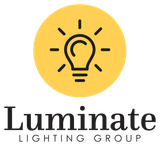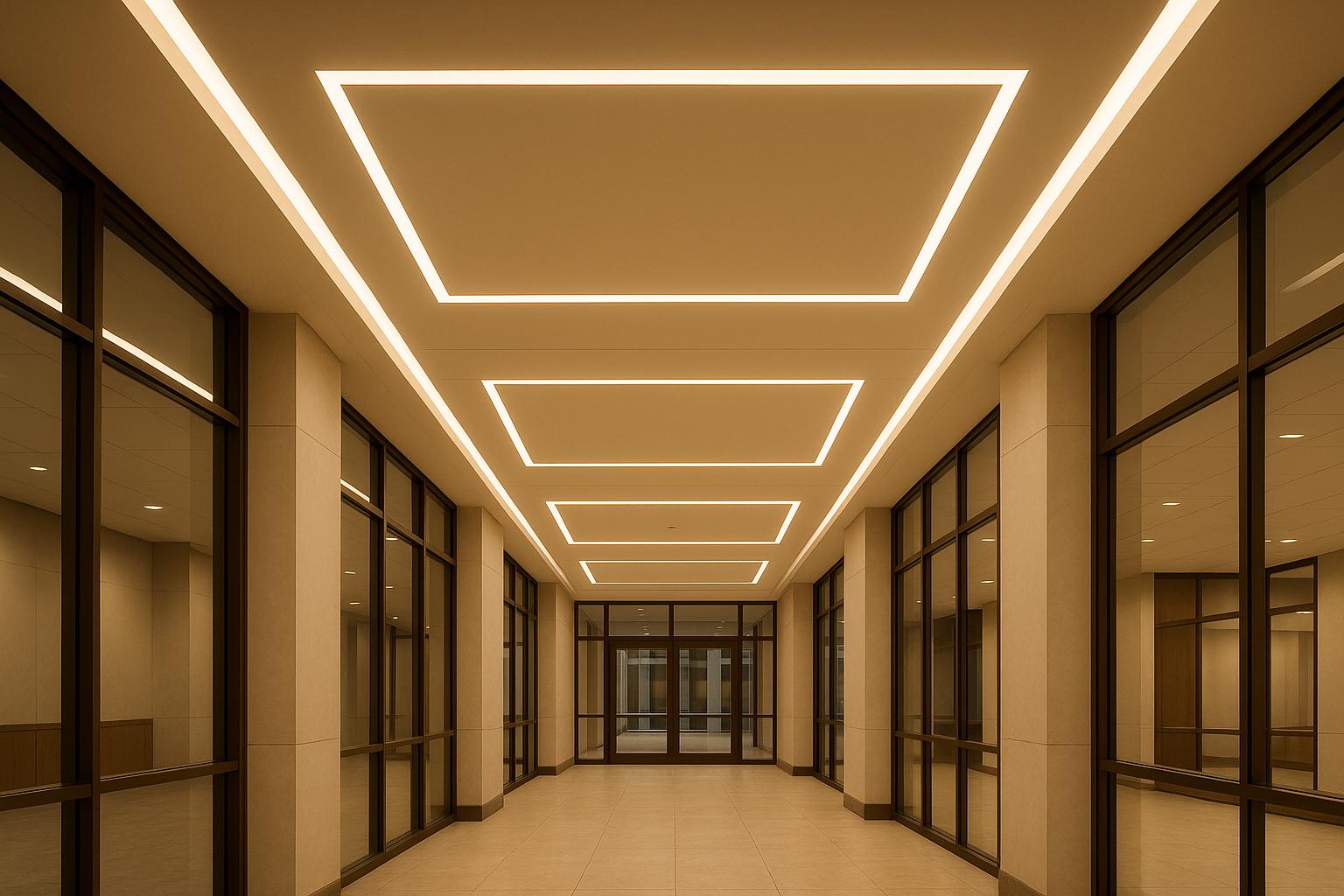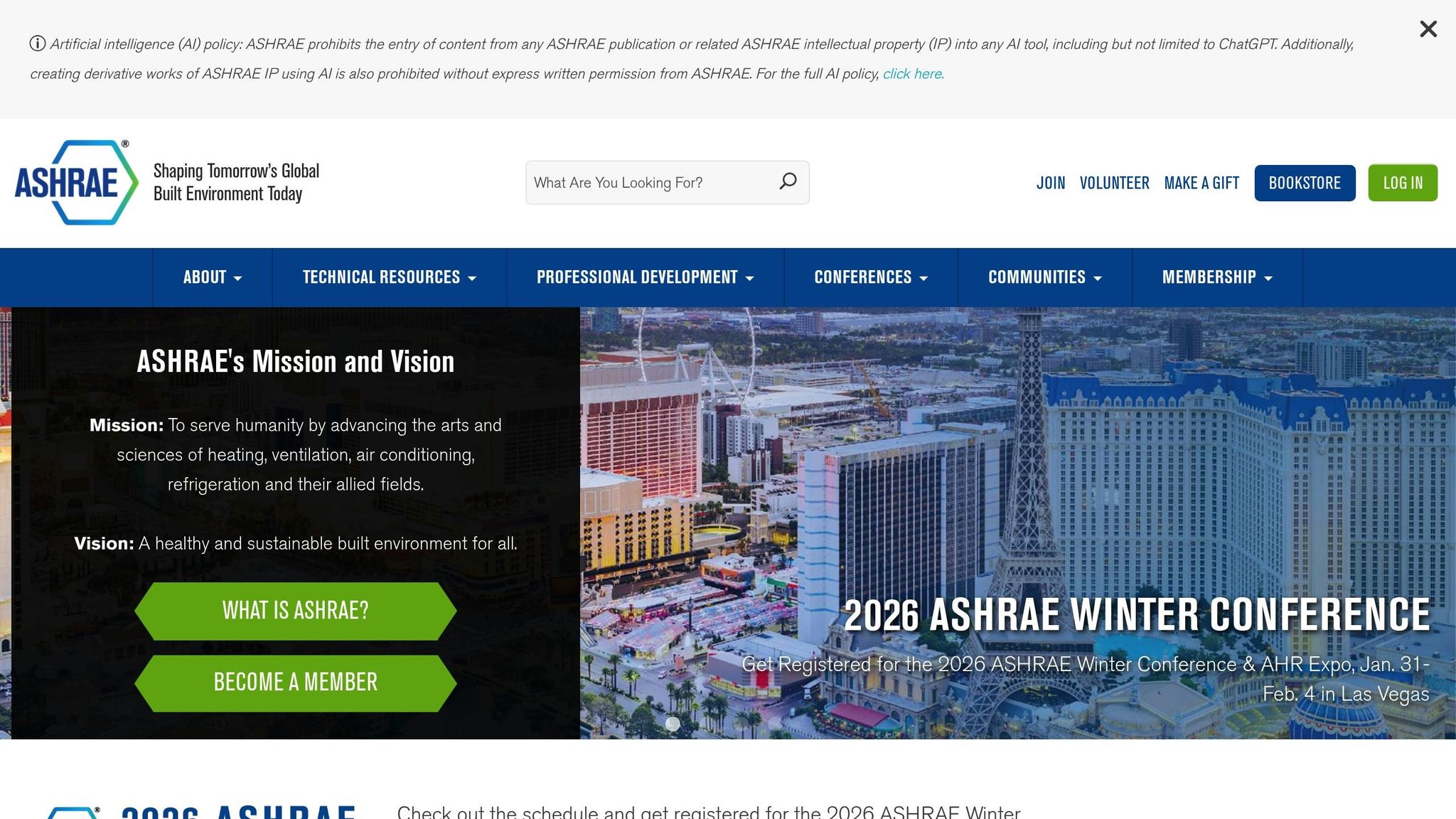Explore how ASHRAE 90.1 standards shape LED lighting design, ensuring energy efficiency, compliance, and significant cost savings for commercial spaces.


ASHRAE 90.1 sets energy efficiency standards for commercial buildings, directly influencing LED lighting design. This standard focuses on reducing energy use through limits on lighting power density (LPD), advanced lighting controls, and daylighting strategies. It is updated every three years to reflect new technologies and practices, with LEDs now serving as the baseline for compliance.
By following ASHRAE 90.1 guidelines, businesses can achieve substantial energy and cost savings while meeting regulatory requirements. Luminate Lighting Group helps streamline this process with energy audits, design, and installation services tailored to compliance.


ASHRAE 90.1 lays out specific guidelines for selecting LED fixtures, control systems, and lighting layouts. These standards are designed to ensure energy-efficient lighting systems in commercial buildings, focusing on three key areas that influence how LED systems are planned and implemented.
Lighting Power Density (LPD) limits set a cap on the maximum watts per square foot for various space types. These limits dictate the selection and number of LED fixtures you can use in a given area.
For example, the 2019 standard specifies different LPD limits based on space function:
In many typical commercial spaces, the LPD limit is set at 1.00 W/ft², covering areas like conference rooms, meeting rooms, training rooms, storage rooms, and restrooms. Parking garages, however, have one of the strictest limits, capped at just 0.14 W/ft², reflecting the minimal lighting needs for these spaces.
To comply with these limits, you can use either the space-by-space method or the building area method. The space-by-space method calculates LPD for each room or area individually, while the building area method applies broader calculations based on the overall building type. Each approach has implications for fixture selection and layout.
ASHRAE 90.1 emphasizes the use of automatic control systems, which align well with the capabilities of LED lighting. These systems go beyond basic on/off switches, incorporating advanced features like occupancy and daylight-responsive controls.
Additionally, the standard requires independent controls for each space, meaning every room or area must have its own switch or occupancy sensor. Some exceptions apply to areas like security lighting, building lobbies, retail stores, and hotel guest rooms, which have slightly different requirements.
ASHRAE 90.1 also addresses exterior lighting, focusing on areas such as parking lots, walkways, and building facades. These standards include both maximum wattage allowances and mandatory control systems.
The 2022 update reduced power allowances for exterior lighting, taking advantage of advancements in LED efficiency. Wattage limits vary depending on the function of the outdoor space and its safety needs.
For exterior lighting, automatic shutoff controls are a must. These controls, which typically use time clocks or photocells, ensure that lights are turned off during daylight hours. Like interior systems, exterior controls aim to minimize energy waste while addressing security and safety requirements.
Parking lot lighting is given special attention, with standards that balance energy efficiency and safety. For example, controls may require partial shutoff during low-activity periods while maintaining minimum illumination levels for security.
When planning exterior LED retrofits, any project involving more than 10 luminaires or 20 linear feet must comply fully with ASHRAE 90.1. Smaller projects may have fewer requirements, but understanding the full standard ensures a well-designed system regardless of scale.
Meeting ASHRAE 90.1 standards for LED lighting systems requires a methodical approach, ensuring both compliance and meaningful energy savings. From assessing current conditions to verifying performance, each step plays a critical role in achieving an efficient and effective lighting design.
Every successful ASHRAE 90.1-compliant project starts with a comprehensive energy audit of the existing lighting system. This involves gathering detailed data on fixture types, wattages, control methods, and usage patterns across the facility.
Key data points include the number of fixtures, their wattage, the square footage they illuminate, and their operating hours. This information helps calculate the lighting power density (LPD) for each space type. It's also essential to note special-use zones, such as areas that operate 24/7 or have safety-critical requirements.
The baseline assessment reveals where the current system falls short of compliance and highlights potential upgrades. With this foundation, you can accurately estimate energy savings and develop a targeted strategy for your LED retrofit.
Choosing the right LED fixtures and controls is crucial for meeting ASHRAE 90.1 standards. Look for high-efficacy fixtures (lumens per watt) and controls such as occupancy sensors, daylight harvesting systems, and scheduling mechanisms.
The requirements for controls vary depending on the space type:
For outdoor lighting, similar rules apply, including wattage limits and control requirements. If you're replacing more than 10 fixtures or 20 linear feet of lighting, the project must comply with Section 9 of the standard.
Enhanced controls like advanced dimming, daylight harvesting, and detailed scheduling not only meet compliance but can also provide extra wattage allowances in certain cases, ranging from 5% to 30%. Ensure all selected products meet the required specifications, including occupancy sensor coverage (up to 5,000 ft²) and automatic off controls that activate within the required 20 minutes.
Once fixtures and controls are selected, the next step is to validate their performance. Proper documentation and testing are essential to confirm compliance. This includes creating detailed fixture schedules, control diagrams, LPD calculations, and commissioning reports.
Testing should cover all control functions, such as occupancy sensors, daylight dimming, and scheduled shutoff systems, under real-world conditions. Commissioning agents should simulate scenarios to ensure every space meets its control requirements.
Additionally, measuring actual power consumption helps verify that the calculated LPD values align with code requirements. For tenant improvements or alterations, documentation must clearly demonstrate compliance, whether using the prescriptive or space-by-space method.
If testing reveals any deficiencies, they should be addressed and resolved before final approval. Thorough documentation not only ensures code compliance but also supports utility rebate and tax incentive applications. This step is critical for achieving projected energy savings and maintaining long-term compliance with ASHRAE 90.1.
Designing LED lighting systems to align with ASHRAE 90.1 standards offers more than just meeting code requirements. It opens the door to both financial and operational advantages that deliver lasting value.
Switching to ASHRAE 90.1-compliant LED lighting can slash lighting energy use by 30% to 60% compared to older technologies, with total savings reaching as high as 80% when combined with advanced controls [4, 7, 11, 12]. These reductions translate directly into lower utility bills.
LED systems also dramatically cut maintenance expenses. With lifespans ranging from 50,000 to 100,000 hours - compared to just 10,000 to 20,000 hours for fluorescent lamps - LEDs can reduce maintenance costs by up to 70% over a decade [1, 2, 15].
Adding lighting controls like occupancy sensors and daylight harvesting systems, as required by ASHRAE 90.1, can boost energy savings by an additional 20–30%. For example, a retail space utilizing these controls can achieve up to a 50% reduction in lighting energy use compared to a basic LED retrofit [1, 2, 3, 6].
The energy and maintenance savings from ASHRAE 90.1-compliant LED upgrades also unlock valuable financial incentives. Many utility companies across the U.S. offer rebates ranging from $0.10 to $0.50 per watt saved [1, 2, 15]. On top of that, the federal 179D tax deduction allows building owners to claim up to $1.80 per square foot for energy-efficient lighting upgrades. For instance, a 50,000 sq. ft. facility could qualify for up to $90,000 in tax deductions.
In 2025, Luminate Lighting Group is assisting businesses in Texas and Arkansas with securing utility rebates by streamlining the pre-qualification process, handling paperwork, and ensuring reimbursement. This service reduces upfront costs and enhances the return on investment.
These incentives make the payback period for ASHRAE 90.1-compliant LED projects especially appealing, often ranging from 1.5 to 4 years. For instance, a warehouse retrofit in the Midwest achieved payback in just 2.3 years, while projects in high-energy-cost regions like California can see payback in under 1.5 years [1, 2, 15]. A real-world example involves a 50,000 sq. ft. office building in California that upgraded to ASHRAE 90.1-2019 compliant LED lighting. This project reported annual energy savings of $18,000, maintenance cost reductions of $7,000, a $25,000 utility rebate, and a $90,000 179D tax deduction, all leading to a payback period of less than two years [1, 2, 15].
Beyond immediate savings, these systems prepare facilities for future requirements.
ASHRAE 90.1 evolves every three years to incorporate advancements in technology and stricter efficiency benchmarks [2, 7, 11]. Designing LED systems to meet current standards ensures facilities are better positioned to comply with future updates without incurring costly retrofits. For example, the 2019 update reduced Lighting Power Density (LPD) requirements by an average of 5% compared to the 2016 version, while the 2022 edition introduced even stricter control measures [4, 2, 7, 11].
Proactively adopting these standards helps buildings remain compliant as more states adopt ASHRAE 90.1 as their baseline energy code [1, 2]. This forward-looking approach not only minimizes future upgrades but also supports broader sustainability efforts. For instance, a municipal building that upgraded to LED lighting reported a 40% reduction in carbon emissions from lighting, aligning with its city's climate action goals [1, 2, 15]. Additionally, ASHRAE 90.1-compliant LED systems contribute toward achieving LEED certification and other green building initiatives.

Luminate Lighting Group specializes in designing and installing LED lighting systems that align with ASHRAE 90.1 standards for commercial spaces. Their approach covers everything from initial assessments to verifying system performance, ensuring a seamless and efficient process.
To kick things off, Luminate conducts detailed energy audits to establish a project's starting point. These audits help identify current energy usage and specific lighting requirements. By integrating ASHRAE 90.1 standards - like limits on lighting power density and mandatory control systems - they ensure every design meets or exceeds compliance benchmarks.
The design phase focuses on selecting fixtures and controls tailored to the building's needs. Features like occupancy sensors and daylight harvesting systems are incorporated based on factors such as building type, usage patterns, and natural light availability.
"Our solutions are designed not only to improve visibility and safety but also to reduce energy consumption, lower maintenance costs, and create sustainable spaces that enhance productivity and overall facility performance." - Luminate Lighting Group
Luminate takes care of every aspect of the project, from selecting fixtures and controls to installation and post-installation verification. Their team ensures that all lighting systems are commissioned and thoroughly documented to confirm compliance with standards like lighting power density limits and control requirements.
Their turnkey LED retrofit services include everything: design, permitting, and installation by licensed electricians. They specify controls such as occupancy sensors, daylight harvesting systems, dimming features, and scheduled shut-off timers to suit each space's unique needs.
To ensure compliance, Luminate provides commissioning reports and measures actual energy use. These reports are not only important for satisfying code officials but also for securing utility rebates and tax incentives. Additionally, they assist clients with applications for utility rebates and 179D tax deductions.
"Our licensed electricians ensure full code compliance and minimal disruption to your operations." - Luminate Lighting Group
This streamlined process is supported by their extensive expertise across a variety of industries.
Luminate's broad experience spans warehouses, industrial facilities, office buildings, and municipal projects. This diversity allows them to address the unique needs of different building types. Their knowledge of municipal codes and public sector requirements ensures smooth compliance and project success for government clients, whether upgrading public spaces or retrofitting city buildings for improved energy efficiency.
For municipal projects, they often handle exterior lighting upgrades, ensuring compliance with zone-specific wattage limits and automatic shut-off controls. Office spaces benefit from scheduled shut-off systems and vacancy sensors, while warehouses typically use motion-activated controls to cut down on energy waste during inactive periods.
To stay ahead of the curve, the team keeps up with updates to ASHRAE 90.1, IECC, and state-specific codes by participating in industry training and professional organizations. This commitment ensures their designs incorporate the latest standards and control technologies.
Clients frequently report energy savings of 50–80% after switching to Luminate's energy-efficient LED solutions. Their proven expertise across multiple sectors ensures long-term compliance, enhanced energy efficiency, and support for sustainability goals - all while improving occupant comfort and overall building value.
ASHRAE 90.1 plays a key role in shaping how LED lighting systems are designed, installed, and operated in commercial buildings across the U.S. By enforcing strict lighting power density limits, requiring advanced controls, and mandating performance verification, the standard ensures both energy efficiency and high-quality lighting outcomes.
More than just meeting regulatory requirements, compliance with ASHRAE 90.1 delivers measurable financial rewards. Many commercial buildings see energy use drop by 40–60% after upgrading to compliant LED systems, translating into annual savings of $10,000–$20,000 in many cases. These savings can grow even further with utility rebates and 179D tax deductions, which reduce upfront costs and speed up the return on investment.
The standard also emphasizes advanced lighting controls, such as occupancy sensors, daylight harvesting, and continuous dimming, ensuring systems perform efficiently over the long term. Regular updates to ASHRAE 90.1 - every three years - mean compliant installations stay aligned with the latest technologies and regulatory expectations. This forward-thinking approach helps minimize future retrofit expenses while supporting corporate goals like reducing carbon emissions.
At Luminate Lighting Group, we specialize in energy audits, custom lighting designs, and turnkey installation services to help your project meet ASHRAE 90.1 standards. With our expertise, you can achieve energy savings of 50–80% while optimizing performance. Let us help you make the most of what ASHRAE 90.1 has to offer.
ASHRAE 90.1 establishes energy efficiency standards for commercial buildings, with specific guidelines for lighting systems. These standards influence the selection of LED fixtures and controls by prioritizing energy-saving features such as efficient luminaires, dimmable drivers, and advanced lighting controls like occupancy sensors and daylight harvesting systems.
To meet ASHRAE 90.1 requirements, LED lighting designs must adhere to power density limits and control specifications, ensuring energy-efficient performance. Choosing LED solutions that align with these standards can help businesses lower energy expenses, enhance lighting quality, and access benefits like utility rebates and 179D tax deductions.
Upgrading to an LED lighting system that meets ASHRAE 90.1 standards can lead to a massive reduction in energy use - often between 50% and 80%, depending on your current setup and facility requirements. These savings directly lower your utility bills, making it a smart move for cutting ongoing operational expenses.
On top of that, meeting ASHRAE 90.1 standards could qualify your business for utility rebates and 179D tax deductions, adding even more financial perks to the equation. Beyond the cost savings, energy-efficient lighting helps you stay compliant with energy codes, supports long-term sustainability goals, and enhances the overall lighting quality in your space.
To ensure your LED lighting designs remain compliant with ASHRAE 90.1 standards and prepared for future updates, prioritize energy efficiency and adaptability. Choose lighting systems that go beyond the current efficiency benchmarks. This extra margin can help you stay ahead if standards become more stringent down the line.
It's also wise to collaborate with professionals who specialize in energy-efficient lighting and keep up-to-date with ASHRAE 90.1 revisions. For example, teaming up with a provider like Luminate Lighting Group can help you create systems that not only meet compliance requirements but also deliver significant energy savings and long-term environmental benefits.